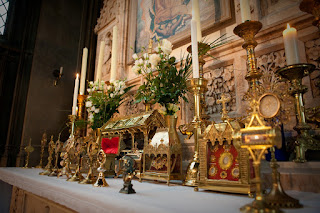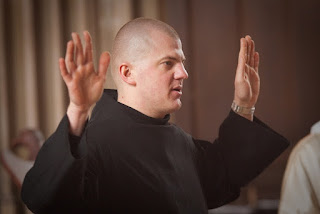The Italian blog Cantuale Antonianum posted the following video from the archives of the Istituto Luce, showing the Corpus Christi Procession at St. Peter’s Basilica in the year 1933. The opening title of the video reads, “Corpus Domini (the usual Italian name for Corpus Christi) in Rome. Escorted by the Pontifical Gendarmes and the Palatine Guards, accompanied by 17 Cardinals, His Holiness Pius XI blesses the crowd in St. Peter’s Square from the ‘talamo’ (‘thalamus’ in Latin) of silver and gold.” At 1:21 we see the umbracula of the Patriarchal Basilicas emerging from the church, and one of the tintinnabula, bells which were suspended in a decorative frame and often rung during processions. At 2:17, we first see Pope Pius XI on the ‘talamo’, which is described by the poster at Cantuale Antonianum as “...a portable structure used by the Pope during the Corpus Domini procession. It was made of a base with rings on its side, into which beams (of wood) could be inserted, holding a small platform on which a monstrance and stool were mounted. The Pope could sit on the stool during the long procession, and the great papal mantle was wrapped around the support of the monstrance. The Pope however would always appear to be kneeling before the Holy Sacrament as he was carried in procession in the square.”
It should be remembered that 1933 was also the year of an Extraordinary Jubilee, proclaimed by Pope Pius XI on Epiphany of that year, and running from Passion Sunday of 1933 to Easter Monday of 1934, (both occurring on April 2 of their respective years.) Assuming 33 A.D. as the year of Our Lord’s Death and Resurrection, it was held to honor the 19th centenary of Human Redemption. This was the first Jubilee to be held with the full public ceremonial in over a century; in 1850, no Jubilee was held because of the chaos in Rome brought about by the Roman Republic, and although Jubilees were proclaimed in 1875, 1900 and 1925, they were kept with minimal ceremony due to the occupation of Rome and the Papal States by the Kingdom of Italy. (It is not an accident that the Bull of Indiction for the Jubilee of 1875 begins with the words, “(Moved) by the grave calamities of the Church and this age”!) The full celebration of the Extraordinary Jubilee of 1933 was made possible by the Lateran Treaties in 1929, finally bringing peace between the Italian State and the Papacy after 59 years. Pope Pius XI also elevated the feast of the Most Precious Blood to the highest rank (Double of the First Class) as the annual liturgical commemoration of the Jubilee. It may be supposed that the incredibly large crowds which are seen in the Piazza in this video are due at least in part to the fact that it was both Corpus Christi and a Jubilee. (In 1983, Pope John Paul II proclaimed a second such Extraordinary Jubilee, for the 1950th anniversary of our Redemption; the original Jubilee cycle began in the same way, so hopefully there will be another in 2033.)
Corpus Christi is a medieval latecomer to the Church year, and this may be the reason why different languages have different names for it. In English and Spanish, it is traditionally called ‘Corpus Christi’, but in Italian ‘Corpus Domini’, (as we see in the opening title of the video), in French, ‘Fête-Dieu - God-feast’, or more freely ‘feast of God,’ and in Polish ‘Boże Ciało - Body of God’. In German, it is called ‘Fronleichnam’, a literal translation of ‘Corpus Domini’. This is a compound of the Old German word ‘Vrone - Lord’, and ‘Leichnam - body’, and has been retained as a traditional name for the feast even though ‘Leichnam’ has come to mean ‘corpse’ in Modern German: not the result of theological carelessness, but a reminder that the Eucharist is also a “memorial of the death of the Lord”, as St. Thomas says in the hymn Adoro te devote. In the Ordinary Form, the formal Latin title of the feast was changed to ‘The Solemnity of the Body and Blood of Christ’; the words ‘and Blood’ were added when the Feast of the Precious Blood was removed from the General Calendar, the most widely protested such removal.
It should be remembered that 1933 was also the year of an Extraordinary Jubilee, proclaimed by Pope Pius XI on Epiphany of that year, and running from Passion Sunday of 1933 to Easter Monday of 1934, (both occurring on April 2 of their respective years.) Assuming 33 A.D. as the year of Our Lord’s Death and Resurrection, it was held to honor the 19th centenary of Human Redemption. This was the first Jubilee to be held with the full public ceremonial in over a century; in 1850, no Jubilee was held because of the chaos in Rome brought about by the Roman Republic, and although Jubilees were proclaimed in 1875, 1900 and 1925, they were kept with minimal ceremony due to the occupation of Rome and the Papal States by the Kingdom of Italy. (It is not an accident that the Bull of Indiction for the Jubilee of 1875 begins with the words, “(Moved) by the grave calamities of the Church and this age”!) The full celebration of the Extraordinary Jubilee of 1933 was made possible by the Lateran Treaties in 1929, finally bringing peace between the Italian State and the Papacy after 59 years. Pope Pius XI also elevated the feast of the Most Precious Blood to the highest rank (Double of the First Class) as the annual liturgical commemoration of the Jubilee. It may be supposed that the incredibly large crowds which are seen in the Piazza in this video are due at least in part to the fact that it was both Corpus Christi and a Jubilee. (In 1983, Pope John Paul II proclaimed a second such Extraordinary Jubilee, for the 1950th anniversary of our Redemption; the original Jubilee cycle began in the same way, so hopefully there will be another in 2033.)
Corpus Christi is a medieval latecomer to the Church year, and this may be the reason why different languages have different names for it. In English and Spanish, it is traditionally called ‘Corpus Christi’, but in Italian ‘Corpus Domini’, (as we see in the opening title of the video), in French, ‘Fête-Dieu - God-feast’, or more freely ‘feast of God,’ and in Polish ‘Boże Ciało - Body of God’. In German, it is called ‘Fronleichnam’, a literal translation of ‘Corpus Domini’. This is a compound of the Old German word ‘Vrone - Lord’, and ‘Leichnam - body’, and has been retained as a traditional name for the feast even though ‘Leichnam’ has come to mean ‘corpse’ in Modern German: not the result of theological carelessness, but a reminder that the Eucharist is also a “memorial of the death of the Lord”, as St. Thomas says in the hymn Adoro te devote. In the Ordinary Form, the formal Latin title of the feast was changed to ‘The Solemnity of the Body and Blood of Christ’; the words ‘and Blood’ were added when the Feast of the Precious Blood was removed from the General Calendar, the most widely protested such removal.

















.jpg)























